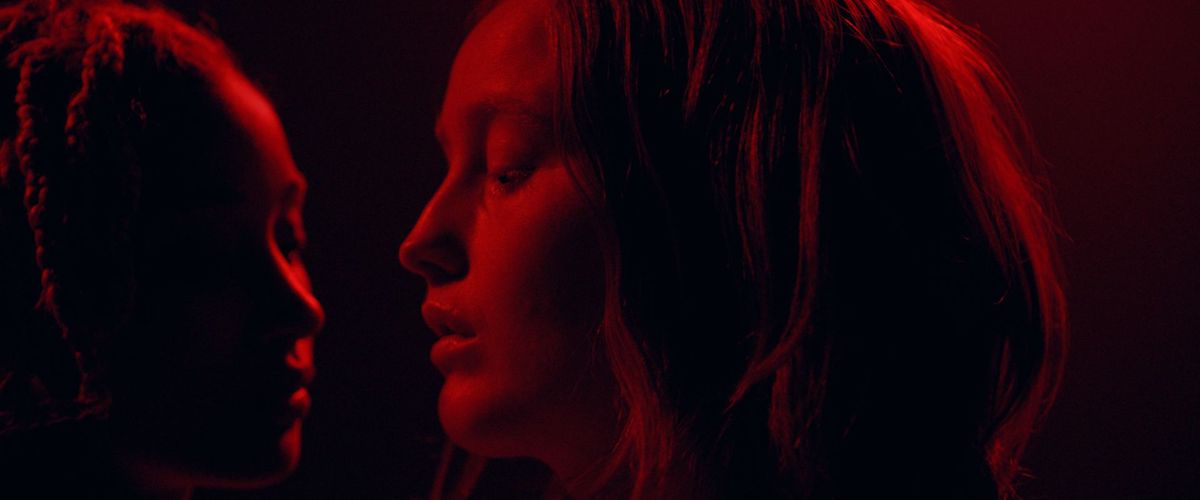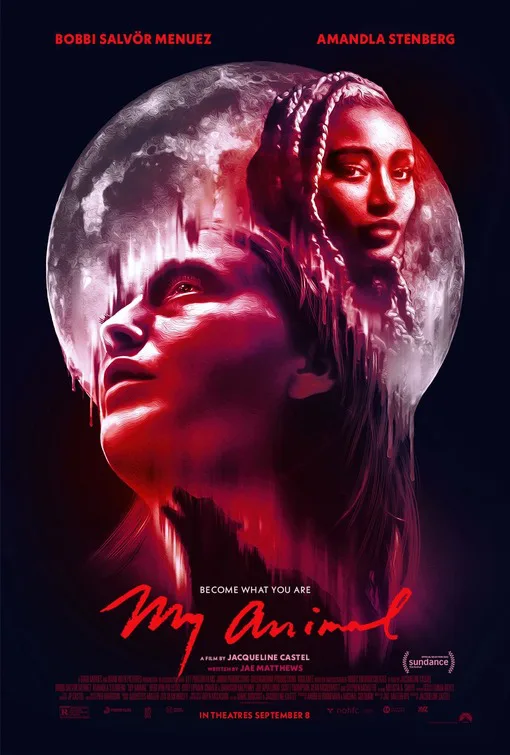There’s more unconvincing teenage drama than horror suspense in Jacqueline Castel’s “My Animal,” a queer-themed werewolf pic that’s both achingly sincere and emotionally stillborn. Most of “My Animal” tracks Heather (Bobbi Salvör Menuez, from “Euphoria”), a lonely teenage misfit, as she dates another girl. Heather’s nose also sometimes bleeds, and she occasionally struggles with visions of the full moon and some howling wolves. These Freudian anxieties are loosely tied to Heather’s feelings for her alcoholic mother, Patti (Heidi von Palleske), who sometimes curses at Heather and is generally overprotective.
Unfortunately, Heather’s two main relationships, with her mom and her would-be partner Jonny (“Bodies Bodies Bodies” star Amandla Stenberg), rarely enhance each other. The werewolf parts of “My Animal” are also mainly teased, which is only distracting given how belabored and contrived Heather’s coming-out narrative otherwise tends to be.
The most resonant scenes in “My Animal” concern Heather’s frustrated ambitions as a hockey goalie. Her father, Henry (Stephen McHattie), provides support despite being distant and perhaps a little too comfortable living in a snowy, isolated little town. In any case, hockey—mostly practicing the sport, but also watching and talking about it with dad—grounds Heather in a specific way to seem real. The same can’t be said about Heather’s too neatly elided connection with her mom, whom Heather tries to avoid, and her girlfriend Jonny, who drinks, drives, and hangs out with a rowdy group of friends at a local pool hall.
Granted, “My Animal” is a tragic character study about a repressed young woman who cannot really connect with others despite her sometimes valiant and often clumsy efforts. At the same time, there’s something fundamentally missing from Heather and Jonny’s story, and it seems to be a sense of life and loss that extends beyond clichéd, pseudo-universal symbols of reckless youth. And while Jonny and Heather’s relationship isn’t unbelievable, it’s usually so undistinguished that it’s hard to get lost in. We learn only so much about these two characters from harshly front-lit, pseudo-dreamy makeout sessions. These heated and very red scenes only look cheap and affected given the skittish and sometimes flat-out rushed scenes that precede and follow.
These shortcomings might have been surmountable given a more rigorous focus on the inviting and/or potentially threatening details of Heather’s suggestive process of self-discovery. Sometimes, water cascading over the camera lens or visually stretching the world out using a fish-eye lens gives viewers the faint impression of emotions that the filmmakers otherwise rarely tap into. A wan synthesizer score likewise only calls back to more atmospheric movie music. This moody and sparse score is especially frustrating given that it was composed by Augustus Muller of the electronic duo Boy Harsher; the group’s other half, vocalist Jae Matthews, scripted “My Animal.”
Heather and Jonny’s creators sometimes inadvertently bury their characters’ feelings in features-obscuring silhouettes and by-the-numbers teen and family drama. That lack of variation isn’t surprising, though, since most of the adult characters are defined by their provincial hangups, while most adolescent protagonists follow their gut. Meanwhile, the inescapable snow, the dead woods, and the constricting backroads that connect them don’t reflect much beyond hackneyed symbols of grief and solitude. A room lit only by an old TV set playing a live-action version of “Beauty and the Beast” only expresses so much when the camera, the lighting, and the human performers don’t get to embellish the scene’s main concept.
McHattie and Menuez’s chemistry stands out partly out of necessity as their relationship gives viewers an essential warmth and world-defining flavor that, say, Jonny and Heather’s intensely felt but unremarkably expressed relationship does not. Still, it’s worth noting that McHattie, a veteran character actor, lends an earthy credibility to his dialogue. He also brings out the best in Menuez, who doesn’t often get to show off what she can do given her characters’ inexpressive dialogue, behavior, and general presentation.
Eventually, the lack of werewolf-related carnage is the least concerning thing about “My Animal.” Some viewers might be able to see themselves and their struggles reflected in Heather, though that will ultimately say more about the road the filmmakers have chosen to travel than the movie that they actually made. Some tropes also remain evocative, like the image of a full, blood-red moon as it transforms into a lone gigantic eyeball. Even a rare lycanthrope sighting looks good enough to be suggestive, at least as far as makeup and lighting go. But the rest of “My Animal” accidentally stresses the limits of our understanding, presumably so that we, as passive viewers, can fill in the blanks for ourselves.
Now playing in select theaters and available on digital platforms on September 15.




















